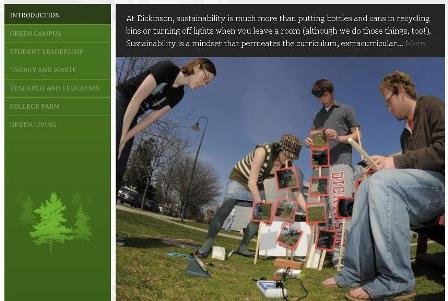We have much more to do and your continued support is needed now more than ever.
Luring Students with the Promise of Green

Colorado College, whose sustainability efforts include signing the President’s Climate Commitment, a 25-kilowatt solar array, a comprehensive climate action plan, a garden, pervious parking lot pavings and yearly participation in the RecycleMania competition, spent three months developing a virtual tour, though many of the projects it covers have been more than ten years in the making. The site offers screens on all these initiatives and a handful of others, including videos, written descriptions and photos. Unlike a conventional, written Web page, the site is designed to draw a viewer in by engaging him or her on multiple media levels.
The site is an indication, says assistant director of facilities George Eckhardt, “that sustainability has become part of our culture and part of our capital structure now. We can talk about it thoroughly and publicly.” He also hopes that it will motivate more students and staff to participate. “The more noise we make, the more people will get involved,” he says.
The site is aimed towards a general audience that includes current students, alumni, and community members. However, perhaps the most important sector is prospective students, who increasingly make college decisions based on green qualifications.
When the Princeton Review released its 2010 college rankings, it announced that it would include information on environmentally related policies, practices, and academic offerings for 697 schools, due to student interest in colleges that prove their committment to long-term sustainability. (Colorado College is one of the 15 schools that the Princeton Review highlighted with the highest possible score.) After surveying almost 16,000 applicants and their parents, the Review had found that 66% of respondents indicated “they would value having information about a college’s commitment to the environment…Among that cohort, 24% of respondents overall said such information would “very much” impact their (or their child’s) decision to apply to or attend the school.”
Dickinson College, another school with an advanced visual tour, guides a reader through images of its green features, with fuller explanations available at a click. One description, superimposed over a photo of students maintaining a roof solar panel, reads, “All majors study their place in the world, the natural environment and their role in complex issues such as energy management and climate change, while applying their learning directly into campus or community policy and development. Students are involved in solar-panel installation, the college’s investment and finance committees, food services and more.”
However, outreach to prospective students is not so comprehensive at other schools, even ones with impressive records on climate action. National Wildlife Federation’s Campus Report Card noted that only a minority of schools have recruitment programs in place to attract students interested in studying environmental and sustainability issues, and that the number has dropped from 25% to 19% between 2001 and 2008: a counter-intuitive shift, considering the number of students who say they consider environmental concerns when they choose colleges.
It’s possible that sites like those at Dickinson and Colorado College are at the forefront of a new trend, particularly as students use the internet for most or all of their college research. Eckhardt says: “For prospective students, it’s nice to have that come up in a web search. There’s nothing better than a visual, and it shows the commitment we have. A lot of the stops on that tour have to do with students: it’s not all about energy and facilities people installing equipment on the back end.”





















